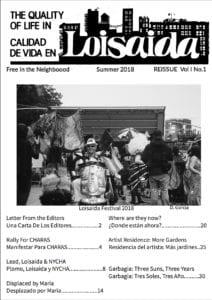
Over the past 10 weeks, I have had to the privilege to learn how the Loisaida Center functions with a small staff to provide programming for their community. The project that we worked on, creating a reissue of the Quality of Life in Loisaida Magazine, was a learning experience for me that took time and careful planning. In the beginning stages, we had not formulated a concrete project for my residency, but I was ready to work on whatever was needed at the moment and I also had ideas about starting an oral history project around the experiences of people coming to new york in the wake of hurricanes that hit Puerto Rico in 2017. When we decided to go through with creating the zine, I was easily able to translate my work over to that project and continue working on stories that seemed important to me.
I often questioned what the best strategies for communication and execution were and I found out along the way that some strategies were effective and some were not. I worked with three full-time staff who were often busy with any number of programs and grant applications. I was hesitant at first to ask for help when I needed a question answered or wanted to have a conversation about something. In my other work as a coordinator for NYU’s Office of Sustainability, we would hold meetings weekly and discuss, and if I had questions there were designated lines of communications and ways to check if someone was available for questioning. At the Loisaida Center, I realized that if I had to talk to the team about something, I had to not worry about inserting myself, as that was how employees would communicate with each other, and this created a much more organic working environment.
The time that I spent working at the Loisaida Center forced me to contemplate my positionality and think deeply about my role in the urban landscape. While researching the original Quality of Life in Loisaida magazine for our project, it became clear to me that the publication served a very important role in the fabric of the community. In the time that the magazine was published, the internet and cell phones had yet to be invented, making rapid communication difficult (although I had heard of radio stations set up in the community by activists to notify people about protests and quicker mobilization.) On top of this, the Lower East Side struggled with disenfranchisement and poverty, (which is still prevalent today) meaning access to resources and information was a significant challenge. With little social services in a time where federal spending was being cut drastically, assistance in all of its forms was sparse. The Quality of Life in Loisaida magazine was able to bridge the gaps in where information was lacking. This included services, information on how to recycle, where to find affordable food, and all of this was written in English and Spanish in order to make it accessible to as many people as the editors could. Through my studies of urban development and sociology, access to information is crucial to successful communities. When individuals have the resources to navigate systems they have a better chance at making a comfortable income and raising a family that can continue to build knowledge through generations. As an academic institution, NYU aims to educate its students but also create a network of people that can build knowledge within its community. However, an issue that confronts institutions like NYU is that knowledge is passed to a select set of people, while the community that the institution exists in is excluded. This creates an urban landscape with high inequality. A big part of my work as a fellow was to bridge the gap between the prestigious exclusive academic institution and the local community. This has felt like an important part of my work and the project of recreating the Quality of Life in Loisaida magazine seemed very symbolic because of this. I was honored to be able to contribute to the project and going forward, the Urban Democracy Lab can continue to build important connections in community organizations with future fellows.

Leave a Reply